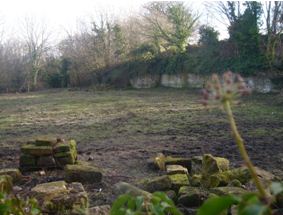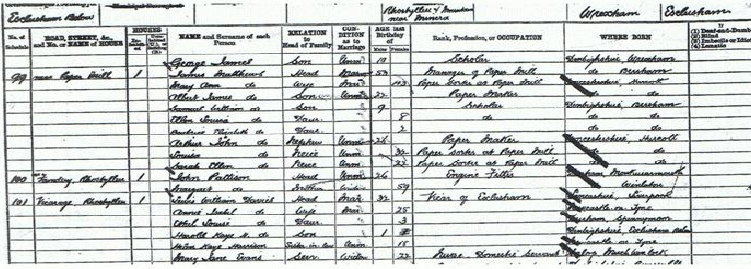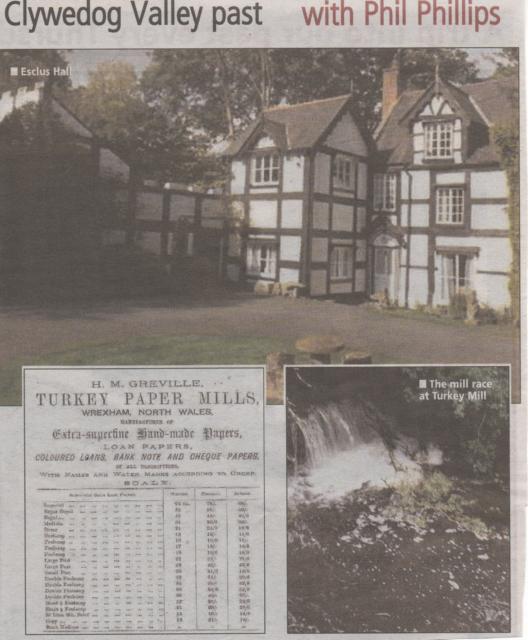
Rhostyllen
A history through pictures

Bersham Paper Mills

In the post-
Bersham/Top Mill (known as Rolling Mill Works) used the same waterwheel and buildings as John Wilkinson’s East Works. In 1818 William and Joseph Harris leased the site from Ann Wilkinson, widow of the iron master, for 45 years @ £103 per annum. The lease was later sold to Thomas Fitzhugh of Plaspower, even though William Harris continued to operate the works. The mill consisted of two buildings on either side of the waterwheel. The water was controlled from a weir at the ‘Argie’ (the Welsh word for dam or weir is ‘Argae’). The weir would raise the level of the water at the leat’s mouth. The gap in the low stone wall on the near side at the top of the waterfall would suggest that it was the position of a sluice-

Sluice-
Esless/Bottom Mill: Edward Bozley bought this corn mill in 1813 from Joseph Clubbe’s son, Thomas, for £2450 (these names will appear again for Esclusham Mill). He converted it to a paper mill and built a distinctive classical style house on the site. After Bozley died in 1814, Richard Hughes & Co took over the mill. He left to open a paper store in Bank Street, Wrexham, and established the stationery firm of Hughes & Son in Hope Street. In 1852 it was sold for only £850 to Ellis Phillips but was never worked as a paper mill again. It became a chamois leather manufactory in 1875 and later the Wrexham Steam Laundry Co, before falling into disuse. Today little remains of the former mill buildings or the house at the bottom of Esless Lane to the right of the little bridge.

Esclusham Mill/Turkey Mill: the landowner Joseph Clubbe built the mill in 1799 and let it to Edward Bozley on a 40-

Site of Turkey Mill


Leat or Millrace
Side view of Laurel Grove
It is this last mill, which became the most famous and employed the most people. It specialised in extra superfine handmade paper for use in banknotes, chequebooks, account books, writing and drawing paper with names and watermarks. In 1810 Bozley transferred the lease to George and William Harris of Liverpool [A Welsh Bible printed by Painter in Wrexham starts on Bozley paper and ends bearing the watermark ‘Harris 1811’]. Bozley died in 1814 and his widow, Ann, stayed on at Esclusham Lodge. In 1831 William and Joseph Harris bought the mill outright from Thomas Clubbe, now a bankrupt, taking out two mortgages on this and Esless Mill.
Sometime during the 1840s the name Esclusham Mill was changed to Turkey Mill. The origin of the name is unknown but since there are other Turkey Mills in Britain, it could have been a make of paper based on the colour Turkey Red or possibly a denotation of good quality. The Harris family became bankrupt and all their Bersham property was sold at auction in Liverpool in 1850 for £5250.
The era of Henry Methold Greville, a Northampton chemist, began in 1854 when he leased the Mill and Laurel Grove from the new owner. He died seven years later and his widow, Anne, and son, Charles, bought the property outright for £4400. By 1881 there were 74 employees under the manager James Matthews. Charles died in 1894 and the business was continued by his sister, Emily, helped by managing director Robert Dover.
The mill burnt down in 1897 causing a huge loss of stock and great hardship to those employed there. Local residents in the villages sent a letter of sympathy to Laurel Grove and formed a relief fund for those put out of work. H M Greville & Son issued a statement full of optimism that the mill would soon be back in business. This became urgent, as they had a pending order for £2000 with the Indian Government.
Soon after this fire Mrs Ann Greville died at the age of 85 and her funeral was attended by all the mill workers. Robert Henry Done, a Wrexham Alderman, purchased the mill and set about rebuilding it. Many improvements were made to the now fireproofed building, including a 60HP engine to supplement the work of the waterwheel, a water tower, office and boardroom. Emily entertained guests at Laurel Grove for the new opening ceremony. She too died in 1900 at the age of 60 and the house was advertised to be let. The mill continued under various owners until the outbreak of the First World War, always using the Greville & Son watermarks. Wood pulp gradually replaced rag as the main raw material for papermaking and hand-
Paper Making Techniques:
- Prepare raw materials: cut the rags to separate the fibres and reduce them to pulp. Sometimes they were left to rot until fermentation took place. They were then washed and pulped at a ‘Stamping Mill’, a water-
powered system of heavy mallets to crush the rags. - Formation of paper: a mixture of water and pulped fibres was known as “stuff”. It was kept warm in vats heated by charcoal stoves. A ‘vatman’ would use a mould to form the sheets of paper: a rectangular wooden frame with a wire mesh over it and a wooden rim called a ‘deckle’ to prevent the stuff flowing off the mould. He would dip the frames into the “stuff” and lift them out, ensuring there was an equal cover through the wire mesh. He would then remove the deckle and pass the mould to a ‘coucher’, who would turn it over and deposit the wet sheet on felt. The coucher would continue to make a pile until he had a post of 144 sheets. The post would be pressed to remove as much water as possible. He would then pass them to a ‘layer’ to remove the felts, return them to the coucher who would press them again.
- Drying and Finishing: the sheets were hung out to dry in the loft at the top of the mill. The dry paper would be coated or glazed with ‘sizing’ to prevent it from absorbing ink. Sizing consisted of a gelatine made from slaughtered animals. Watermarks could be added by sewing a pattern onto the wire meshing.
Employees: In the latter part of the nineteenth century it is possible to see from censuses who the manager of the Turkey Mill was. In 1881 the mill was quite a family affair for James Matthews:

His address is written as ‘Near paper Mill’, presumably Esclusham Lodge at Laurel Grove. Ten years later the manager is John Isgar, who was living at Rose Cottage, Rhostyllen, before moving into the mill accommodation. He had moved from Somerset to work in the Bersham paper industry and now lived with his wife and eight children in the ‘Turkey Paper Mill House’.

John Matthews was a 23 year old foreman who had worked at the mill for thirteen years. He started in the ‘picking engine’ at 2s per week (“I picked bits of dirt out of the pulp as it was turned in the vat by the engine”). He was now earning 23s per week as foreman and was responsible for hiring the boys and girls, some of whom were paid ‘by the piece’ and could earn 1s. 6d. more than those paid by the day. Girls were employed from the age of 11 as rag cutters, glazers and paper sorters; boys worked as ‘engineers’ on the beating machines. Even though the hours were long, work conditions were generally good and workers were allowed an hour to go home for dinner. The boys and girls had had little education and were mostly illiterate.
There were also jobs for rag collectors, who would tour houses to collect unwanted cloth and sell it directly to the mills. The ‘Rag and Bone’ man was a common sight in the nineteenth century, especially after the Irish Famine when many people emigrated from Ireland to Wales and England.
Today: Nothing remains of the Top Mill at the site of the former Bersham School; only the weir at the ‘Argae’ reminds us of the past heritage. The Esless/Bottom Mill became a private house before demolition in the 1960s; the Harper family lived there for many years until they moved to Henblas Road, Rhostyllen. The Turkey Mill was converted into a private residence and remains so to this day. (Eryl Jones)

Bersham Paper Mill Workers c1894
“This is a picture of workers from Bersham Paper Mill, c1894. My great grandmother, Emma Price from Machine House, is seventh from the left front row. Her first born son, Charles Hampden Edwards (my grandfather) married the young girl, Emma Evans, at the front of the group.
Charles and Emma married at Plas Power Chapel (Bersham church) on 17th June 1901 My grandfather was at one time, a barber in Rhostyllen, then Wrexham. They lived for a while at Y Fraich, Aberoer and later at Canal Cottages on Croesnewydd Road” (Janet Robinson)



Esless Mill Fire Insurance Plate




Bersham Paper Mills -
I